The violent universe as
seen only by high energy astronomy

Planets,stars and galaxies are formed from incredible explosions deep within our universe. These explosive events release a phenomenal amount of energy and are often invisible from within the earth's atmosphere.
Visible light is only a small part of the electromagnetic spectrum. Beyond the ultraviolet region of the spectrum the wavelengths continue to increase in energy as they decrease in length. Click to see the electromagnetic spectrum above. These wavelengths decrease to the size of an atom and even smaller to the size of sub-atomic particles. Such small wavelengths are not able to penetrate the earth's atmosphere, lucky for us as this radiation is deadly. Energetic and catastrophic explosions release high energy gamma and X-rays. We can see the aftermath of such events by looking for gamma and X-rays and this can only be done with space telescopes equipped with sophisticated sensors. Such telescopes have given rise to high energy astronomy.
Earth's atmosphere blocks out most of the high energy radiation that approaches it from space. It is therefore necessary to have telescopes high above the atmosphere looking deep into space collecting UV and infrared radiation as well as X-ray, microwaves and gamma rays. Light and radio waves easily reach the Earth's surface and can be studied by ground based telescopes.
The ozone layer blocks out most of the harmful UV radiation and infrared and microwaves are absorbed by water molecules in the lower levels of the atmosphere. Energetic X-rays are abosrobed when they collide with atoms in the atmosphere.
Several specialised sattelites study a range of energies from the electromagnetic spectrum. For example:
- microwave and infrared radiation is studied by the Cosmic Background Explorer, developed by NASA and launched in 2008.
- infrared radiation was studied by the Infrared Astronomical Satellite launched in 1983 and lasted ten months

Any object heated to over 1,000,000 degrees Celsius will begin to give off significant amount of X-rays. The image on the right is an x-ray image of our Sun. The Sun is not a big emitter of X-rays, its surface temperature is a relative low 5800K. However, above the surface of the Sun in a region known as the corona gas is heated to millions of degrees by powerful and rapidly changing magnetic fields. This super hot gas can emit X-rays, which is what the image on the right reveals.
Matter heated to between 1 million and 100 million degrees Celsius is in a state known as plasma or ionized gas, which consists of ions and electrons at very high energies.

We often observe X-rays coming off neutron stars more commonly known as black holes. The incredible density of the neutron star strips gases from neighbouring stars. As the gases spiral in towards the neutron star they are heated to incredible temperatures and become a source of high energy X-ray radiation.
Click to see an x-ray image of such an event.
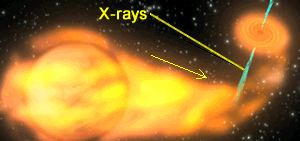
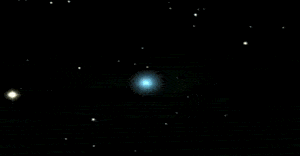
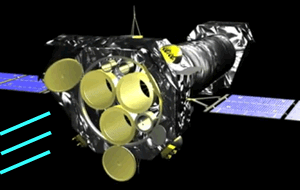
The gas emitted in a supernova explosion is extremely hot, so it emits X-rays as well as visible light. By studying the X-ray light, astronomers can see different things when looking in the X-ray.
Click to see X-ray image of the same supernova remnant.
Picture from http://imagine.gsfc.nasa.gov/docs/teachers/hera/spectroscopy/snr/snr_profile.html
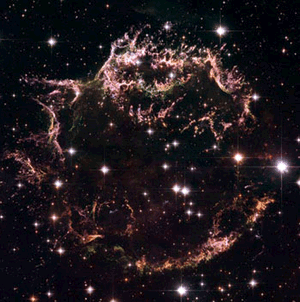
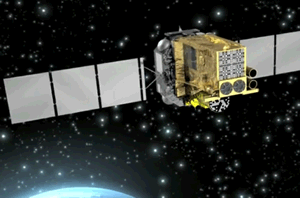
Infrared radiation is best known as heat. This type of radiation is also a part of the electromagnetic spectrum. It is invisible and its wavelengths are longer and less energetic than those of the highly energised and dangerous gamma and X-rays. Almost all objects emit some form of infrared radiation (heat). In fact any object with a temperature above -273 oC will emit heat.
Even an ice cube emits heat, as seen in the infrared image on the right. The purple region being the coldest.
In space,regions are obscured from view by optical telescopes by dust and gas. However, infrared radiation, which has longer wavelengths than visible light, can pass through regions of dust and gas without being scattered thus making such objects visible in the infrared region.
In the infrared, astronomers can gather information about the universe as it was a very long time ago and study the early evolution of galaxies. As a result of the Big Bang, the Universe is expanding and most of the galaxies within it are moving away from each other. As a result of this all of the ultraviolet and much of the visible light from distant sources is shifted into the infrared part of the spectrum, red shifted, by the time it reaches our telescopes. This is known as the Doppler effect and the only way to study this radiation is in the infrared.
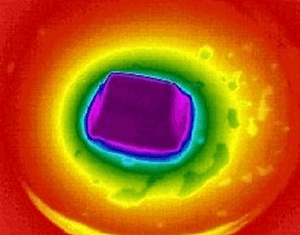
Since most of the infrared radiation that hits the Earth is absorbed in the atmosphere, by water vapour and carbon dioxide, the surface of the Earth is not a very good place to observe objects in the infrared. Satellites are equipped with special infrared sensors that scan the sky with spectacular results.
NASA'a Cassini spacecraft in November 2005 turned its infrared sensors onto a moon of Saturn called Enceladus and revealed a volcanic heat source that spewed steam kilometres into orbit. The infrared image is shown on the right. At a certain location, on the Southern pole, giant geysers are created by a subterranean heat source that shoots 100 kg of water every second at a speed of nearly 2,000 km/hr high into orbit.
This is a great discovery as the two main ingredients for life, water and an energy source, are present on Enceladus.

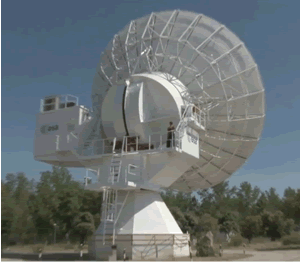

Click to see the image of the Crab Nebula created by superimposing the X-ray (blue), and optical (red) images.
Click to see the supernova SN 1987A in the Large Magellanic Cloud. It is the nearest supernova detected since the invention of the telescope. Almost 20 years after its discovery on 23 February 1987, XMM-Newton observed the stellar remnant in X-rays on 17 January 2007. Continuously brightening since the first detection in X-rays by ROSAT in 1992, it now outshines all other X-ray sources in its immediate neighbourhood and it is more than ten times brighter as compared to the first-light observations of XMM-Newton in January 2000.
Click to see an Spitzer Space Telescope image of Messier 82